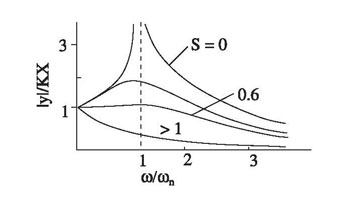|
While the first order system unconditionally attenuates the input, second order can amplify it in the neighbourhood of the natural frequency  for for  . A nearly uniform frequency response is obtained for S = 0.6 and . A nearly uniform frequency response is obtained for S = 0.6 and  (Figure 2.23) and this value of the damping factor is commonly used in the design of instruments. (Figure 2.23) and this value of the damping factor is commonly used in the design of instruments.

Figure 2.23: Periodic Response of a Second Order System. |
As a rule mechanical systems are second order systems due to their inertia while fluid systems are of first order and electrical systems containing all the three elements  , ,  and and  are of second order. are of second order.  systems are of first order and systems are of first order and  - systems of zeroth order. A hot-wire anemometer working in the constant temperature mode with feedback will be shown later to be nearly a zeroth order system and hence close to an ideal probe. - systems of zeroth order. A hot-wire anemometer working in the constant temperature mode with feedback will be shown later to be nearly a zeroth order system and hence close to an ideal probe.
The performance of certain probes that are commonly used in thermal sciences are described below by examining their transient behaviour. |